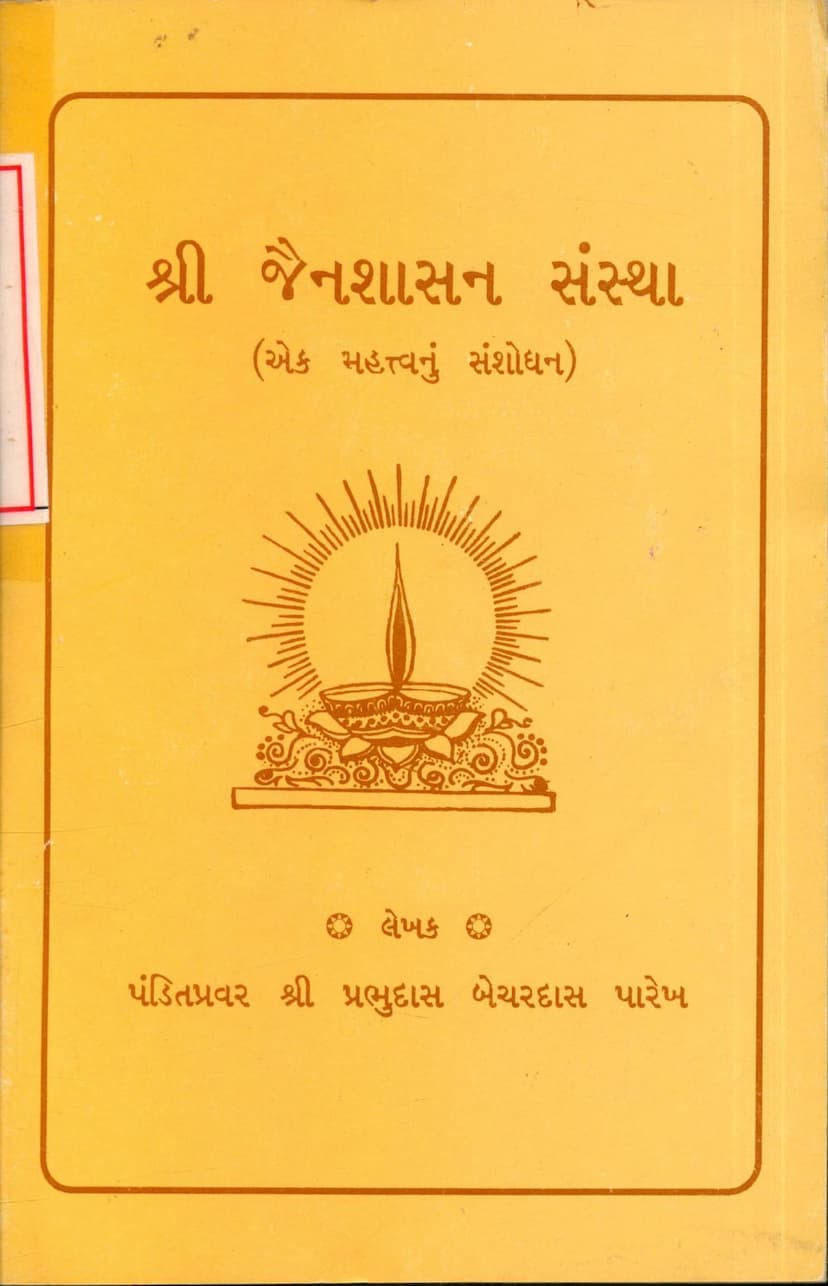Jain Shasan Samstha
Added to library: September 2, 2025

Summary
Here's a comprehensive summary of the Jain text "Jain Shasan Samstha" by Prabhudas Bechardas Parekh, based on the provided pages:
Book Title: Jain Shasan Samstha (Jain Governance/Institution) Author: Pandit Prabhudas Bechardas Parekh Publisher: Viniyog Parivar
Overall Theme: The book is a profound exploration and defense of the Jain "Shasan" (Governance/Institution), emphasizing its central role in the spiritual development and well-being of not only Jains but the entire world. The author argues for the vital importance of adhering to the principles and structure of the Jain Shasan, especially in the face of contemporary challenges and the perceived decline in adherence.
Key Concepts and Arguments:
-
The Significance of Tirthankaras and the Jain Shasan:
- Tirthankaras as Founders: Tirthankaras are presented as the originators of the Jain Shasan, which is described as a divine, universal, and highly organized institution for spiritual upliftment. They establish the path of spiritual development and the organizational structure (Shasan) to support it.
- Shasan as the Core: The Shasan is more than just a religion; it's a comprehensive system that guides individuals towards spiritual liberation (moksha). It is the foundation upon which Jain Dharma, the Sangha (community of monks and nuns), scriptures, and religious practices are built.
- Worship of Tirthankaras: The profound respect and worship given to Tirthankaras stem from their role as the founders and exemplars of this perfect system. Their lives, teachings, and the events in their lives are central to the Jain way of life.
-
Defining the Jain Shasan:
- A Universal Institution: The Jain Shasan is depicted as a central, constitutional institution for the entire universe, established by the Tirthankaras. It's the ultimate guide for spiritual progress.
- The Five Pillars: The Jain Shasan is understood through five key components:
- The eternal Dharma (spiritual path).
- The constitutional Shasan-Tirth institution that makes the Dharma accessible.
- The Chaturvidha Sangha (four-fold community of monks, nuns, laymen, and laywomen) as the administrators.
- The Dvadasangi (Twelve Limbs of scripture) as the guiding knowledge.
- The wealth of religious practices, spiritual potential (Ratnatrayi), and commitment (both material and spiritual).
- The Importance of "Namo Tiththassa": This sacred phrase signifies bowing to the Shasan, the institution that makes the path to liberation achievable.
-
The Author's Critique of Modern Trends:
- Erosion of Shasan Adherence: The author laments the current trend of neglecting the Shasan and its principles, often prioritizing individual preferences or modern interpretations over the established structure.
- The Danger of Shasan-Nirapeksha (Shasan-Independent) Practices: Practices performed without regard for or adherence to the Shasan's guidelines are seen as detrimental. They may appear outwardly progressive but ultimately lead to spiritual decay and societal disorder.
- Threats to Jain Dharma: The book highlights external threats, particularly from Western influences and secular governance ("democracy," "majority rule"), which aim to undermine and dilute the core tenets and structures of Jainism.
- The Role of the Sangha: There's a call for the Chaturvidha Sangha to actively protect and uphold the Shasan, rather than passively observing its decline. The author expresses concern that even monastic orders are becoming lax in their adherence.
-
The Shasan as the Foundation of World Welfare:
- Interdependence: The book asserts a direct correlation between the safety and integrity of the Jain Shasan and the welfare of the world. Any harm to the Shasan is seen as harm to global well-being.
- The Shasan as a Guiding Light: It's likened to a lighthouse, a guiding beacon for humanity lost in spiritual darkness and confusion. The Shasan provides clarity, direction, and the means to navigate the path of righteousness.
- The Tirthankaras' Strategic Planning: The establishment of the Shasan by Tirthankaras is portrayed as a meticulous, strategic plan for universal welfare, integrating all aspects of human life (spiritual, social, economic, political) under a divine framework.
-
The Need for Strict Adherence and a Centralized Authority:
- Against Democracy in Religious Governance: The author strongly criticizes the adoption of democratic principles and majority rule within religious institutions, viewing it as a perversion of the divinely ordained, hierarchical structure of the Shasan.
- Restoring the Authority of Acharyas: The book advocates for a return to the traditional structure where Acharyas (spiritual leaders) hold ultimate authority, with guidelines provided by the Tirthankaras and interpreted by learned scholars. A "Kulpit Janaranam" (imaginary proclamation) is proposed to re-establish this order.
- Unity in Adherence, Not Uniformity: While not advocating for a homogenization of all faiths, the text emphasizes the importance of respecting the unique contributions of different traditions while maintaining the distinct and superior structure of the Jain Shasan.
-
The Author's Call to Action:
- Wake-Up Call: The book serves as an urgent call to Jains to recognize the threats to their Shasan and to actively defend it.
- Personal Responsibility: Individuals are urged to examine their own actions and ensure they are aligned with the Shasan's principles.
- The Role of the Current Generation: The author stresses the immediate need for the current generation of Jain leaders and followers to take decisive action to preserve and strengthen the Shasan, rather than waiting for future saviors.
In Essence:
"Jain Shasan Samstha" is a passionate and detailed defense of the Jain governance system, presented as the ultimate framework for spiritual realization and world welfare. It's a deeply traditional work that contrasts the perceived purity and effectiveness of the established Shasan with what the author sees as the corrupting influences of modern, secular, and majoritarian trends. The book implores the Jain community to recognize the critical importance of their Shasan and to actively work towards its preservation and revitalization.